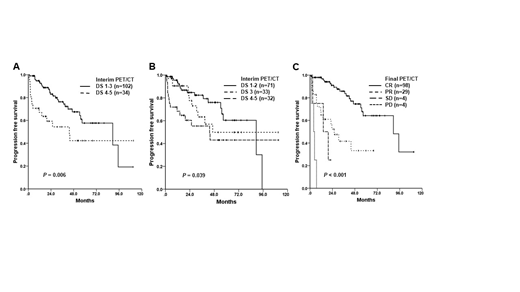Introduction
In aggressive lymphoma, the prognostic value of FDG-PET/CT is well established to assess the response to therapy and predict long-term outcome. However, there are still many controversies for using PET/CT in indolent non-Hodgkin lymphomas because of the low FDG avidity. Therefore, this study was planned to evaluate the roles of PET/CT in marginal zone lymphoma, which is a representative of indolent lymphoma.
Method
We retrospectively analyzed the data of 136 patients with advanced stage marginal zone lymphoma from 13 independent institutions between January 2008 and January 2018. All of the enrolled patients had Ann Arbor stage III-IV except some patients with stage II with bulky mass or rapid progression. Patients were treated with 6th or 8th cycles of immunochemotherapy which consisted of R-CVP (Rituximab, cyclophosphamide, vincristine, prednisolone) (90.4%), R-CHOP (Rituximab, cyclophosphamide, doxorubicin, vincristine, prednisolone) (5.9%), R-B (Rituximab, bendamustine) (3.7%). PET/CT scan was performed at diagnosis, after 2~3 cycles of immunochemotherapy (interim), and at the end of the treatment. Interim PET/CT response was assessed according to Deauville 5-PS (DS) and semi-quantitative assessment based on the rate of reduction in the SUVmax (deltaSUVmax).
Results
The median age of the patients was 59.5 years (range;28.0~84.0), and 115 patients (84.6%) had stage III-IV. 119 patients (87.5%) had one or more extranodal site involvement, and gastrointestinal tract (25%) was the most commonly involved extranodal site. Fifty-one patients (37.5%) were classified into high risks and 85 patients (62.5%) were with low risks based on IPI. The median SUVmax of the lesion was 4.8 (range; 0.8-23.5) on initial PET/CT. According to Deauville 5-PS in interim PET/CT, 37 patients (27.2%) were defined in score 1, 34 patients (25.0%) in score 2, 31 (22.8%) patients in score 3, 27 patients (19.9%) in score 4, and 7 patients (5.1%) in score 5. The optimal cutoff value for the deltaSUVmax was 59.8 according to the ROC analysis. After median follow up of 35.9 months, performance status, LDH, IPI and interim PET/CT response were significant prognostic factors for progression free survival (PFS) in univariate analysis. Patients who achieved complete metabolic response (DS 1-2) showed significantly longer progression free survival (PFS) than patients with DS 3-5 grade (Figure 1A, 89.3 months vs. 43.9 months, P=0.046). However, the semi-quantitative method using deltaSUVmax did not predict the survival outcome. In regard to post-treatment PET/CT assessment, patients who achieved complete response showed long PFS (Figure 1B, P<0.05). In multivariate analysis, complete metabolic response (DS 1-2) achievement in interim PET/CT was the strong prognostic factor in patients with advanced stage marginal zone lymphoma (HR 2.017, 95% CI 0.981-4.147, P<0.05).
Conclusion
Deauville 5-PS based interim PET/CT response assessment is useful to predict the survival outcome of advanced stage marginal zone lymphoma in post-rituximab era. Whereas, the semi-quantitative assessment based on deltaSUVmax did not have the prognostic impact.
Figure 1. Progression free survival of all patients according to Deauville 5-PS based interim PET/CT response (Figure A, B) and post-transplant PET/CT response (Figure C)
No relevant conflicts of interest to declare.
Author notes
Asterisk with author names denotes non-ASH members.


